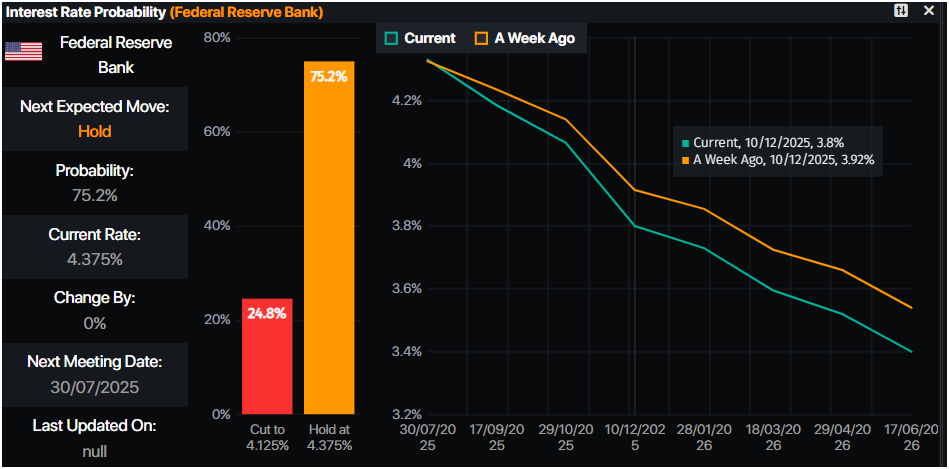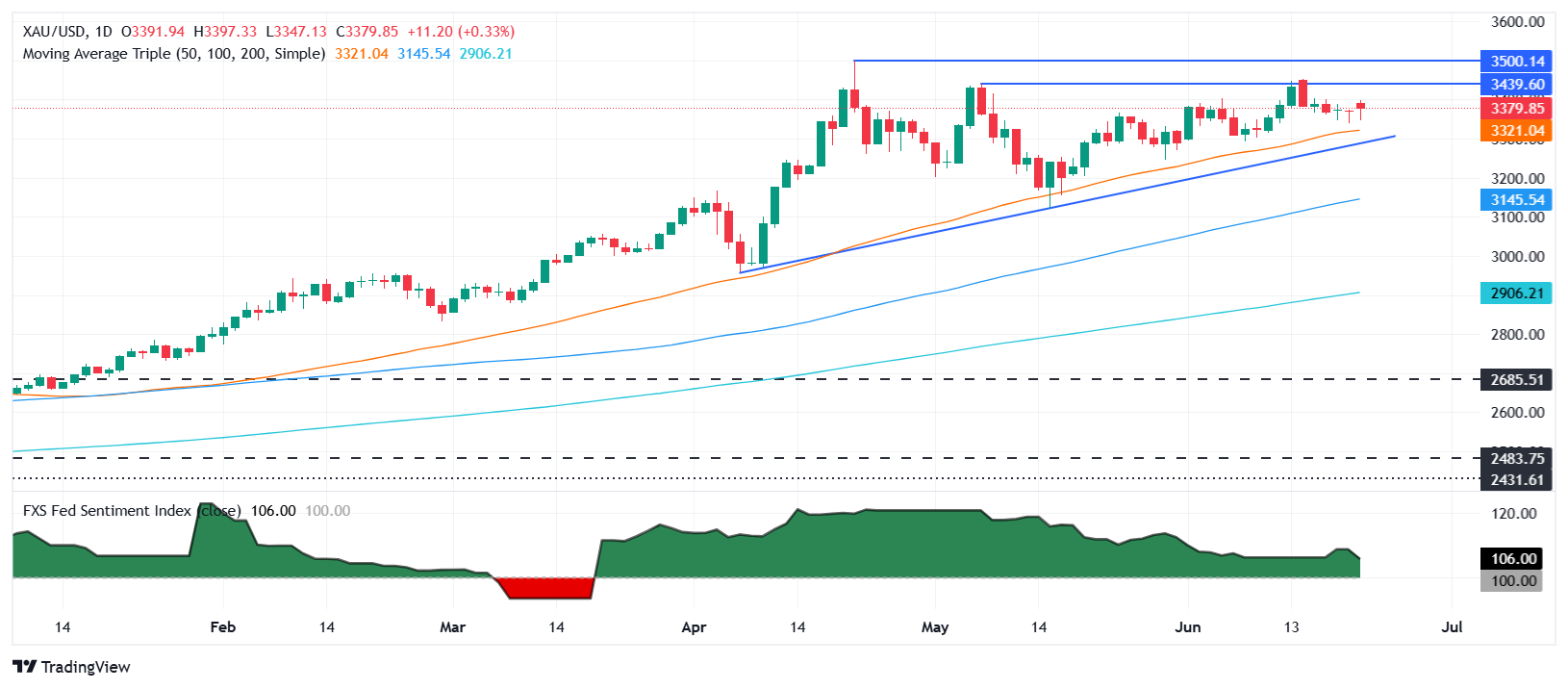- XAU/USD rises to $ 3.385 as the conflict in the Middle East intensifies.
- Iran launches missiles against American bases in Qatar, Kuwait and Iraq; Israel bombs Evin prison in Tehran.
- The governor of the Fed, Bowman, says she is open to a rate cut in July if inflation remains contained.
- The dollar and yields fall, while operators focus their attention on Powell’s testimony and PCE inflation data.
Gold prices remain up during the North American session, since the last minute news revealed Iran’s attack on American bases in Qatar, in retaliation for the weekend attack to Iran’s nuclear facilities by the White House. Meanwhile, US economic data were overlooked mainly due to the intensification of geopolitical tensions in the Middle East. At the time of writing, the XAU/USD is traded at $ 3.385, with an increase of 0.39%.
Macroeconomic data has been set aside while geopolitics monopolizes most holders. Iran reported the launch of missiles against American bases in Qatar, Kuwait and Iraq, according to Arabiya, citing Israeli media. Along with this, Iran replied, approving the closure of the Ormuz Strait and launching missile attacks against Israel.
Meanwhile, Israel attacked Evin prison in northern Tehran, which, according to Reuters, “Israel described its most intense bombing so far from the Iranian capital one day after the United States joined war.”
Gold prices printed another leg up, since the governor of the Federal Reserve (FED), Michelle Bowman, joined the Dovish choir, saying that he is open to reduce interest rates in the meeting of the Federal Open Market Committee (FOMC) of July, if the inflationary pressures are held contained.
The US dollar index (DXY), which tracks the yield of the dollar against a basket of six currencies, falls 0.25% to 98.52. The yields of the US Treasury bonds are also down, which acts as a tail wind for gold prices.
In the data front, S&P Global revealed that the manufacturing activity expanded above the estimates, but has stagnated during the last two months. In the service sector, companies continue to grow at a healthy rate, although the June figure decreased compared to May data.
The economic agenda in the US will feature more Fed speakers, headed by the testimony of the president of the Fed, Jerome Powell, before the US Congress on Tuesday. The operators will digest the latest consumer confidence figures, orders for durable goods, housing and employment data, together with the publication of the Fed’s favorite inflation indicator, the Personal Consumer Price Index (PCE) underlying.
What moves the market today: the recovery of the price of gold extends, while Iran responds on the US bases
- On Saturday, the United States (USA) carried out an attack on three of Iran’s nuclear facilities: Fordow, Natanz and Isfahan. The president of the USA, Donald Trump, described the mission as “a very successful attack” and warned that “there are many other objectives” if Iran are still reluctant to peace conversations.
- The US Midnight Hammer operation involved B-2 Spirit bombers and Tomahawk missiles of US submarines.
- Recently, the US M&P manufacturing PMI for June was 52, above the expectations of 51, but without changes compared to the previous reading. The PMI of services fell from 53.7 to 53.1 in June, a little above the estimates of 52.9.
- The 10 -year American treasure bonus yield has dropped seven basic points (PB) to 4,306%. The real US yields, which are inversely correlated with gold prices, have also dropped, standing at 1,978%.
- The FED monetary policy report recently revealed that there are early signs that tariffs are contributing to greater inflation. However, its complete impact has not yet been reflected in the data. The report added that current policy is well positioned and that financial stability is resistant in the midst of high uncertainty.
- The monetary markets suggest that the operators are discounting 57.5 basic points of flexibility towards the end of the year, according to Prime Market Terminal data.

Fountain: Prime Market Terminal
Xau/USD technical perspective: The price of gold rises to $ 3,400
The increase in geopolitical tensions has caused an upward trend in gold prices, with yellow metal bouncing from minimum daily below $ 3,350, but buyers failed to exceed the figure of $ 3,400. However, the relative force index (RSI) favors buyers in setback, keeping in upward territory.
For a bullish resumption, the Xau/USD must exceed $ 3,400. Once exceeded, the following key resistance levels, such as the 3,450 $ brand and the historical maximum of $ 3,500, are ahead.
On the contrary, if gold falls below $ 3,350, the setback could be extended to the simple mobile average (SMA) of 50 days at $ 3,315. More losses are expected once exceeded, in the converted support of the maximum of April 3 to 3,167 $.

FAQS GOLD
Gold has played a fundamental role in the history of mankind, since it has been widely used as a deposit of value and a half of exchange. At present, apart from its brightness and use for jewelry, precious metal is considered an active refuge, which means that it is considered a good investment in turbulent times. Gold is also considered a coverage against inflation and depreciation of currencies, since it does not depend on any specific issuer or government.
Central banks are the greatest gold holders. In their objective of supporting their currencies in turbulent times, central banks tend to diversify their reserves and buy gold to improve the perception of strength of the economy and currency. High gold reserves can be a source of trust for the solvency of a country. Central banks added 1,136 tons of gold worth 70,000 million to their reservations in 2022, according to data from the World Gold Council. It is the largest annual purchase since there are records. The central banks of emerging economies such as China, India and Türkiye are rapidly increasing their gold reserves.
Gold has a reverse correlation with the US dollar and US Treasury bonds, which are the main reserve and shelter assets. When the dollar depreciates, the price of gold tends to rise, which allows investors and central banks to diversify their assets in turbulent times. Gold is also inversely correlated with risk assets. A rebound in the stock market tends to weaken the price of gold, while mass sales in higher risk markets tend to favor precious metal.
The price of gold can move due to a wide range of factors. Geopolitical instability or fear of a deep recession can cause the price of gold to rise rapidly due to its condition of active refuge. As an asset without yield, the price of gold tends to rise when interest rates lower, while the money increases to the yellow metal. Even so, most movements depend on how the US dollar (USD) behaves, since the asset is quoted in dollars (Xau/USD). A strong dollar tends to keep the price of gold controlled, while a weakest dollar probably thrusts gold prices.
Source: Fx Street
I am Joshua Winder, a senior-level journalist and editor at World Stock Market. I specialize in covering news related to the stock market and economic trends. With more than 8 years of experience in this field, I have become an expert in financial reporting.







